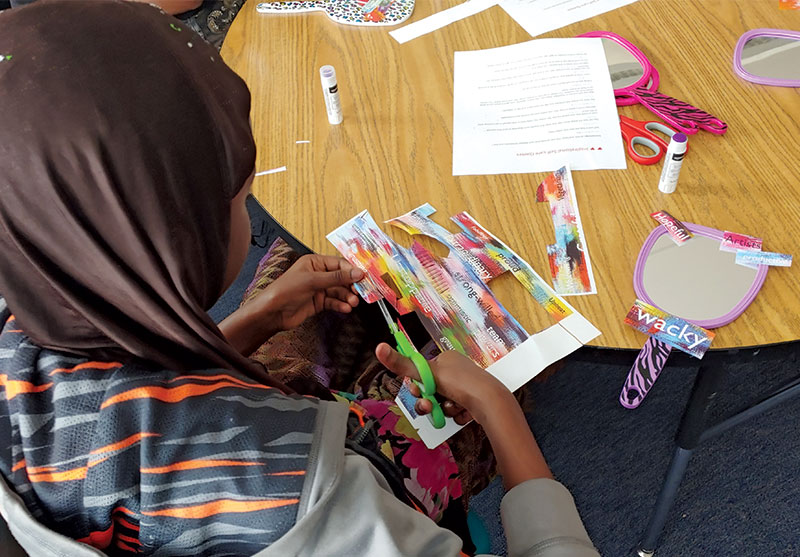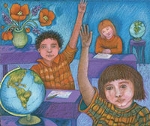Where Healing Happens: Librarians Adopt Trauma-Informed Practices To Help Kids
As childhood trauma is recognized as a public health issue, librarians and educators help students who have experienced violence, loss, and other issues.
 |
Kimberly Grayson, principal at Denver's Dr. Martin Luther King, Jr. Early College,
|
A double homicide spurred Janet Damon, then an elementary school librarian, to begin offering whole-child support in the library, focusing on health in partnership with learning. “Our students had to walk past the crime scene, which was a car parked near our playground, right next to the bus stop,” she says.
That was more than 10 years ago, but Damon, currently a library services specialist for Denver Public Schools, points to the incident as the moment she first became aware of trauma-informed approaches. “I had never experienced anything like that growing up,” she says. “So I began providing more affirming stories and activities in the library.”
Those efforts eventually led to programming focused on building positive relationships and resilience. Damon deepened her knowledge of trauma-informed practices while pursuing her postgraduate degree in school leadership. Now, she offers access to mindfulness practices—self-awareness and tuning in to the present moment—and yoga. She has also established community partnerships for families outside of school.
It was also about a decade ago that Alex Shervin Venet taught English at a small therapeutic school in Vermont, where many students had experienced trauma, including violence or loss of a loved one.
The school staff combined counseling approaches with teaching to help students develop healthy relationships, manage emotions, and explore strengths and weaknesses. “[Our process of providing those supports] was trauma-informed before I knew that ‘trauma-informed’ was a thing,” Venet says.
Now a professional development facilitator specializing in trauma-informed teaching and restorative practices, Venet realized that not all teachers had been trained to work with struggling kids. She began to educate other teachers with the aim of “bringing what we know about trauma and learning to the mainstream.”
Data and science tell us a lot about trauma and its lasting impacts. According to the federal Substance Abuse and Mental Health Services Administration (SAMHSA), before the age of 16, three out of every four children will have experienced or been exposed to a traumatic event. These may include exploitation, violence, natural disasters, loss of a loved one, and military family-related stressors.
“Trauma,” which is commonly defined as an emotional or psychological response to a terrible or deeply distressing event, can also stem from bullying, assault, neglect, accidents, and life-threatening illness. These and other “adverse childhood experiences” (ACEs) have been shown to impact health and development, education, and future opportunities.
“Trauma is a disruption of two basic human needs: safety and community,” says student safety and well-being consultant Julie McDaniel in her webinar “Beyond ACEs: Why Trauma-Informed Practices Are a Call to Action.” “Each subsequent ACE makes a person more vulnerable exponentially.”
The U.S. Centers for Disease Control concurs, reporting that multiple ACE exposures trigger increased risk for chronic health conditions, risky health behaviors, lowered life potential, future violence, incarceration, and early death. In the U.S., nearly 35 million children have experienced one or multiple ACEs.
More attention has been paid to the impact of trauma and ACEs in education in recent years. This is in part because of high rates of violence, suicide, racism, drug abuse, and socioeconomic hardship in the United States that can amplify trauma exposure for children. But it is also because early trauma appreciably influences brain development and learning.
 |
Students at Denver’s Dr. Martin Luther King, Jr. Early College school add uplifting statements to small mirrors for affirmation. |
Frameworks for well-being
The Treatment and Services Adaptation Center, an organization of trauma-informed clinicians, researchers, and educators, reports that exposure to traumatic events can negatively impact a child’s ability to manage emotions and relate to others. This can lead to poor classroom behavior, suspensions, low grades, and reduced graduation rates. Additionally, the Council on Community Pediatrics notes that ACEs can literally alter brain structure and function—impairing cognitive skills and disrupting normal stress responses.
All this knowledge has compelled researchers to develop comprehensive frameworks for policies, procedures, and practices that help traumatized children and adults become more resilient. When used in education, these strategies can provide administrators, counselors, teachers, and staff with the tools to foster awareness and safety, and to help them feel more empowered.
“With learners dealing with ACEs, the fear and apprehension that we all experience can become a chronic condition that affects everything they do,” explains Melissa Gardner, school librarian at Campbell County (KY) Middle School. “That fear can manifest at school into academic and social struggles, absenteeism, and anxiety.”
To address this, many schools and districts embrace trauma-informed teaching, which combines trauma awareness and training with a recalibration in thinking about responses to student behavior. Instead of asking, “What is wrong with this child?” teachers, counselors, and school staff ask, “What happened to this child?”
“Emotional and physical outbursts are treated less as discipline issues and more as red flags for emotional well-being,” says Lauren Dotson Davis, assistant professor in the department of education at Montana State University.
McDaniel similarly describes trauma-informed teaching as a shift from punitive to restorative responses. She stresses that the focus should be on building resilience and strengthening relationships, which can help counter the effects of trauma, rather than on bad deeds or zero tolerance policies, which can exacerbate existing trauma.
Dotson Davis, who was formerly a school administrator, says that when trauma-informed practices were implemented in her school, students were calmer, and teachers were often able to get to the root cause of behavioral issues. “They could then go through proper channels to apply appropriate intervention strategies,” she says.

Nationwide adoption
State Representative Christina Sappey (D-PA) strongly believes there is value in viewing student behavior with empathy. She recently introduced legislation to require trauma-informed training and education in Pennsylvania public schools.
“As a policymaker, it was important to me to help people understand that trauma impacts all of us,” says Sappey. “We have traumatized children everywhere, and the adults in the room have to understand what they are seeing.”
The new education bill was inspired by the work of a comprehensive trauma committee formed to figure out why so many children were not thriving. The legislation, which had bipartisan sponsorship, was eventually incorporated into a Pennsylvania senate bill that was signed into law in July by Governor Tom Wolf.
Once implemented (Sappey anticipates that detailed guidance may go out to schools in 2020), school staff who have contact with children will have to complete training on trauma-informed approaches. The law will also mandate trauma-informed programming in schools and task higher education institutions with training aspiring teachers in trauma-informed practices.
In the meantime, existing state trainings on ACEs will continue. “When the specific policies hit the schools, you will have so many people understanding trauma more than they did 10 years ago,” Sappey says.
Other states such as Massachusetts, Washington, Iowa, and Wisconsin currently have varied school district–wide implementations of trauma-informed education. Similar approaches are taking hold in major city school districts including Chicago, Kansas City, Baltimore, and San Francisco.
Sappey is convinced that by becoming informed and taking the right steps, all educators can change the trajectory of a life. For Pennsylvania, she describes the new law as “a good way to start.”
Denver Public Schools became a trauma-informed district last year. Damon believes that books are a valuable way for librarians to start taking positive action. “This year, we have used book clubs as a trauma-informed practice and an identity-affirming support for students who have experienced trauma,” she says.
|
Online resources SAMHSA.gov
Trauma and Learning Policy Initiative Illustration by Phoebe Stone for TLPI
Room 241 |
Damon points out that reading for just six minutes can decrease stress levels by nearly 70 percent and help students achieve a more relaxed state conducive to learning. “Reading literary fiction improves empathy by helping us tune in to the inner thoughts and introspective lives of characters,” she says.
According to Damon, this “humanizing effect” helps teach students complexity, along with ways to deal with emotions, pain, shame, or heartbreak. That’s why she focuses on stories that help heal the heart.
Damon recently partnered with a local middle school social worker to offer a literacy circle for girls to learn about mindfulness and be exposed to literature in order to deal with stress and anxiety. Local providers offered the girls yoga, dance, and art activities. Thanks to a social media fundraiser, participants received self-care kits filled with books, affirmation cards, and journals.
Recognizing that students of color are often bombarded with negative stereotypes and images (i.e., they experience racial trauma), Damon also partnered with Black Lives Matter to support literacy experiences that affirm the creativity, culture, and traditions of black families.
“One simple read-aloud can do triple duty: increasing empathy, supporting brain development, and decreasing stress,” she says. “In everything we do, we put this knowledge to work bridging culturally responsive and trauma-informed practices to serve our community.”
Trauma-informed spaces
Like Damon, Venet believes that school librarians are in a unique position to help struggling and traumatized students. “Not all kids will feel connected to their teacher,” she says. “The school library can be a lower-stakes environment than a classroom.”
Gardner similarly notes the importance of librarians striving to make students feel welcome, safe, and important. She learned about trauma-sensitive practices through a district-sponsored professional development seminar and adapted them to the school library.
“Often, when a child experiences trauma, a loss of control or space is involved,” she explains. “Students have choices in the library—in the books they read and in the activities they do. Sometimes, just letting students choose where they sit in the library can make them feel empowered.”
In practice, trauma-informed libraries should be predictable environments, with planned transitions, clear boundaries, and explicit behavioral expectations, Gardner adds. “Make your library a place where learners can come to reflect and pull themselves together if they need to.”
Gardner also advocates bibliotherapy to help students. “Learners may identify with a character or develop insight to cope with their problems, which may help them recognize that they are not alone in their experiences.”
To broaden the reach of bibliotherapy, Gardner has started a project with other Kentucky school librarians to identify books for each of the ACEs. Their goal is “to share the list with other librarians, counselors, and teachers, and get those books into the hands of learners to help them become more resilient.”
Venet agrees that books are a powerful way to build resilience to help children cope with trauma. She suggests choosing titles that represent a spectrum of stories and diverse characters and that normalize asking for help and getting support.
“Powerful stories can go a long way in helping struggling kids internalize that it is OK to not be OK and in letting them know that help is out there,” she says.
Connecting with each child
(Adapted from Hummer, V., Crosland, K., Dollard, N., 2009) |
|
|
Connect
Illustrations by taichi_k/Getty Images |
Respect Redirect |
 Kelley R. Taylor is a writer and journalist who loves to cover issues that impact people's daily lives and work. She lives on the East Coast with her husband and twin girls and enjoys writing about law, health, and education.
Kelley R. Taylor is a writer and journalist who loves to cover issues that impact people's daily lives and work. She lives on the East Coast with her husband and twin girls and enjoys writing about law, health, and education.
RELATED
The job outlook in 2030: Librarians will be in demand
The job outlook in 2030: Librarians will be in demand
ALREADY A SUBSCRIBER? LOG IN
We are currently offering this content for free. Sign up now to activate your personal profile, where you can save articles for future viewing




 With trauma-informed approaches, what works for one child may or may not be suitable for another. Finding what is effective is a collaborative effort that often involves planning and training. Here are some essential elements of trauma-informed care.
With trauma-informed approaches, what works for one child may or may not be suitable for another. Finding what is effective is a collaborative effort that often involves planning and training. Here are some essential elements of trauma-informed care. Protect
Protect



Add Comment :-
Comment Policy:
Comment should not be empty !!!
Albert Fish
A delicious selection of observations and opinions.Posted : Oct 09, 2019 08:01